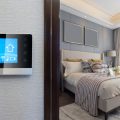1. Why Upgrade to a Smart Thermostat in 2025
Smart thermostats are becoming an essential part of modern homes, and 2025 is shaping up to be the perfect year to make the switch. With rising energy costs and growing interest in smart home technology, upgrading your thermostat can save you money, improve comfort, and give you more control over your homes climate. Heres why its a smart move:
Energy Savings That Add Up
One of the biggest reasons to upgrade is the potential for significant energy savings. Smart thermostats learn your schedule and adjust temperatures automatically to use less energy when youre not home. Many models also provide detailed energy reports so you can track usage and find ways to save even more.
| Feature | Benefit |
|---|---|
| Learning Algorithms | Automatically adjusts settings based on your habits |
| Eco Modes | Saves energy during low-usage times |
| Usage Reports | Helps you monitor and reduce energy consumption |
Remote Access for Total Control
No more worrying if you left the heat on when you left for work. With Wi-Fi connectivity, smart thermostats let you control your homes temperature from anywhere using your smartphone or tablet. Whether youre at work, on vacation, or just lounging in bed, adjusting your thermostat is as easy as opening an app.
Smooth Integration with Your Smart Home
If youre building out a smart home system, a smart thermostat fits right in. Most top models are compatible with popular platforms like Amazon Alexa, Google Assistant, and Apple HomeKit. That means you can control your heating and cooling with voice commands or automate routines that include lighting, security systems, and more.
| Smart Home System | Compatible Thermostats |
|---|---|
| Amazon Alexa | Nest Learning Thermostat, Ecobee SmartThermostat, Honeywell Home T9 |
| Google Assistant | Nest Thermostat, Ecobee3 Lite, Emerson Sensi Touch |
| Apple HomeKit | Ecobee SmartThermostat, Honeywell Lyric T5, Emerson Sensi Touch |
A Smart Investment for Comfort & Convenience
A smart thermostat doesnt just save money—it enhances daily life by making temperature control effortless. Whether it’s waking up to a warm house on a winter morning or cooling things down before you get home from work in the summer, these devices make comfort automatic.
If youre considering an upgrade in 2025, nows a great time to explore the best options available. In the next section, well dive into the top 10 smart thermostats for this year—comparing features, reviews, and what makes each one stand out.
2. Key Features to Look for in a Smart Thermostat
When shopping for the best smart thermostat in 2025, its important to focus on features that offer comfort, energy savings, and seamless control. Here are the key features you should consider before making a purchase:
Learning Capabilities
Smart thermostats with learning capabilities can automatically adjust your homes temperature based on your habits and preferences. Over time, they learn when youre home, away, or asleep, and optimize heating and cooling accordingly—no manual programming needed.
Benefits of Learning Thermostats:
- Adapts to your daily routine
- Reduces energy use without sacrificing comfort
- No need for constant adjustments
Geofencing Technology
Geofencing uses your smartphone’s location to know when you’re leaving or coming home. This feature helps save energy by lowering heating or cooling when no one is home and turning it back up as you return.
Why Geofencing Matters:
- Automates temperature settings based on your location
- Reduces energy waste when the house is empty
- Adds convenience—no need to manually change settings
Voice Control Support
Most smart thermostats now support voice assistants like Amazon Alexa, Google Assistant, and Apple HomeKit. This allows hands-free control of your thermostat using simple voice commands.
Compatible Voice Assistants:
| Thermostat Brand | Alexa | Google Assistant | Apple HomeKit |
|---|---|---|---|
| Nest Learning Thermostat | ✔️ | ✔️ | ❌ (limited via third-party) |
| ecobee SmartThermostat | ✔️ (built-in) | ✔️ | ✔️ |
| Honeywell Home T9 | ✔️ | ✔️ | ✔️ |
HVAC System Compatibility & Integration
A great smart thermostat must work well with your existing HVAC system. Whether you have a single-stage furnace or a multi-zone setup, make sure the thermostat supports your system type. Also, check if it integrates with other smart home devices for full automation.
What to Check For:
- C-wire requirement (for power supply)
- Zoned heating/cooling compatibility
- Integration with smart hubs like SmartThings or Apple HomeKit
Pro Tip:
If youre unsure about wiring or compatibility, most manufacturers offer an online compatibility checker or installation service.
Selecting a smart thermostat with these features ensures you get the most value in terms of comfort, savings, and smart functionality in your home.

3. Top Smart Thermostats of 2025 Reviewed
Choosing the right smart thermostat can make a big difference in your homes comfort and energy bills. We’ve reviewed the top 10 models for 2025 to help you find the best one for your lifestyle and budget. Below, we compare them based on design, ease of use, performance, and value.
Top 10 Smart Thermostats Comparison Table
| Brand & Model | Design | Ease of Use | Performance | Value for Money |
|---|---|---|---|---|
| Google Nest Learning Thermostat (4th Gen) | Sleek metal finish, circular display | User-friendly app, auto-scheduling | Excellent learning capabilities | High-end price but worth it |
| Ecobee SmartThermostat with Voice Control | Modern square design with glass finish | Touchscreen + Alexa built-in | Great room sensor support | Strong features at mid-tier price |
| Amazon Smart Thermostat | Simplistic and clean look | Alexa integration, simple controls | Solid performance for basics | Budget-friendly option |
| Honeywell Home T9 WiFi Smart Thermostat | Slim profile with touchscreen display | Easy installation, intuitive app | Room sensors optimize temperature zones | Good balance of cost and features |
| Tado Smart Thermostat Starter Kit V4+ | Sleek European-style design | User-friendly app, geo-fencing feature | Smart scheduling works well | A bit pricey but efficient savings |
| Mysa Smart Thermostat for Electric Baseboard Heaters | Minimalist white faceplate design | Straightforward interface, mobile app control | Specifically for electric heating systems | Niche product, great for specific needs |
| Sensi Touch Smart Thermostat by Emerson | Larger color touchscreen display | No C-wire required for most systems | Reliable with good energy reports | Affordable with strong support features |
| Bosch Connected Control BCC100 Thermostat | Larger square screen with clear text display | User interface is simple but not very modern-looking | Performs well in multi-stage HVAC systems | Fair pricing with solid functionality |
| LUX Kono Smart Thermostat | Crisp, customizable faceplates available in multiple colors | User experience is easy once set up is complete | Works well with major smart home platforms like Apple HomeKit and Alexa | A stylish choice with reasonable pricing |
Main Takeaways from Our Reviews:
- If style and learning automation matter: Go for the Google Nest Learning Thermostat.
- If you want voice control and room sensors: The Ecobee model offers great value.
- If youre on a tight budget: The Amazon Smart Thermostat covers essential features affordably.
- If you use electric baseboard heaters: Mysa is your go-to option.
This detailed comparison gives you a clear view of what each smart thermostat brings to the table. Whether youre upgrading your system or buying your first smart thermostat, these models offer a wide range of features to meet different needs.
4. How to Choose the Right Thermostat for Your Home
Choosing a smart thermostat can feel overwhelming with so many models and features available in 2025. But don’t worry — finding the right one is all about matching it to your lifestyle, home size, HVAC system, and budget. Here’s a simple guide to help you make the best choice.
Home Size and Layout
The size of your home plays a big role in determining what kind of smart thermostat you need. Larger homes may benefit from models that support room sensors or zoning systems, while smaller spaces might do fine with a basic unit.
| Home Size | Recommended Features |
|---|---|
| Small Apartments or Condos | Basic scheduling, remote access, energy reports |
| Medium-Sized Homes (1,500–2,500 sq ft) | Learning capabilities, geofencing, voice control |
| Large Homes (2,500+ sq ft) | Multi-room sensors, zone control, advanced automation |
Your Lifestyle and Daily Routine
If youre often away from home or have a changing schedule, choose a thermostat with learning features or geofencing. These models can automatically adjust temperatures based on when youre home or away. For those working from home or with consistent routines, manual scheduling might be enough.
Lifestyle-Based Suggestions:
- Busy commuters: Go for a model with geofencing and mobile app control.
- Work-from-home users: Look for comfort-focused features like humidity sensors and smart schedules.
- Tech lovers: Consider thermostats compatible with Alexa, Google Assistant, or Apple HomeKit.
HVAC Compatibility
Not all thermostats work with every heating and cooling system. Before buying, check if your HVAC system is compatible—especially if you have multi-stage heating/cooling or use heat pumps.
| HVAC System Type | Check For |
|---|---|
| Standard Gas/Electric Furnace & AC | Most smart thermostats are compatible |
| Heat Pump Systems | Select models with specific heat pump settings and auxiliary heat support |
| Zoned HVAC Systems | Requires thermostats that support multiple zones or additional accessories |
| High-voltage (line voltage) Systems | Needs special thermostats like Mysa or other compatible models |
Your Budget
Smart thermostats come in a wide price range. While premium models offer more features, even budget-friendly options can save energy and improve comfort. Heres a quick breakdown:
| Budget Range (USD) | What You Get | Examples (2025 Models) |
|---|---|---|
| $70–$120 | Basic scheduling, Wi-Fi control, energy tracking | (e.g., Amazon Smart Thermostat) |
| $130–$200 | Learning algorithms, voice assistant integration | (e.g., Nest Thermostat, Ecobee3 Lite) |
| $200+ | Zoning support, room sensors, advanced automation | (e.g., Ecobee Smart Thermostat Premium) |
A Quick Checklist Before You Buy:
- Is it compatible with your current HVAC system?
- Does it fit your daily routine and lifestyle?
- Can it integrate with your smart home devices?
- Is it within your budget?
- Are rebates available from your utility provider?
Selecting the right smart thermostat isn’t just about tech — it’s about making your life easier and saving money in the long run. Keep these factors in mind as you compare the top models of 2025.
5. Installation Tips and Compatibility Considerations
Installing a smart thermostat might seem intimidating at first, but with the right guidance and a bit of patience, it can be a smooth DIY project. Here are some helpful tips to ensure your new smart thermostat works seamlessly with your existing HVAC system.
Check Compatibility Before You Buy
Not all smart thermostats work with every heating and cooling system. Before making a purchase, it’s important to verify compatibility with your current setup. Most manufacturers offer an online compatibility checker—just enter your HVAC system details to see if the thermostat will work.
Common HVAC System Types:
| HVAC System Type | Smart Thermostat Compatibility |
|---|---|
| Conventional (Gas/Oil/Electric) | Most models compatible |
| Heat Pump | Select models required (look for dual-fuel support) |
| Radiant or Boiler Systems | Limited compatibility; check specs carefully |
| Zoned Systems | May need multiple thermostats or add-ons |
C-Wire Requirement
A C-wire (common wire) provides constant power to your smart thermostat. While some models can operate without one using battery backup or power stealing technology, having a C-wire is generally recommended for reliability.
If You Don’t Have a C-Wire:
- You can use a C-wire adapter kit (often included with the thermostat)
- You may need professional installation if rewiring is necessary
Pre-Installation Checklist
- Turn off power: Always switch off power to your HVAC system at the breaker before starting installation.
- Take a photo of existing wiring: This helps you reference wire placement when installing the new unit.
- Label wires: Use stickers (usually included in the box) to label each wire based on its terminal connection.
Troubleshooting Common Issues
If your smart thermostat isn’t powering up or connecting properly, consider these quick fixes:
- No power? Double-check that the wires are fully inserted into the correct terminals.
- No Wi-Fi? Make sure your home network is 2.4GHz-compatible if your thermostat doesn’t support 5GHz.
- Error messages? Refer to the manufacturer’s app or website for specific troubleshooting steps.
When to Call a Pro
If youre dealing with high-voltage systems (like baseboard heaters), complex multi-zone setups, or are unsure about wiring, its best to hire a licensed HVAC technician. Many smart thermostat brands also offer certified installer networks for peace of mind.
A successful installation ensures your smart thermostat delivers energy savings, comfort, and convenience as intended. Taking time to prep and confirm compatibility will help you get the most from your investment in 2025 and beyond.


